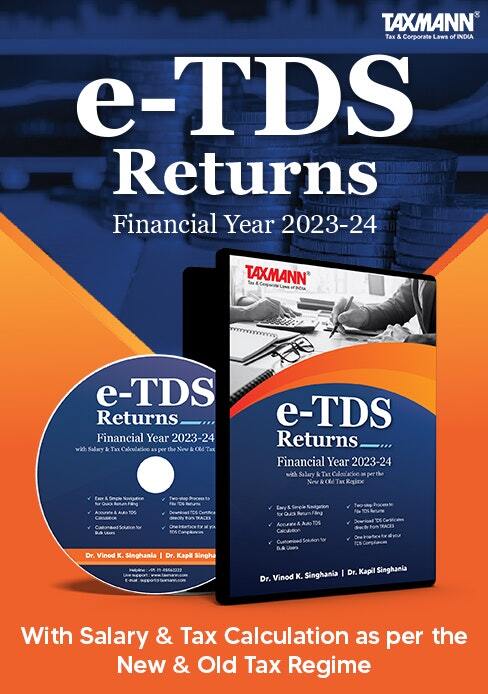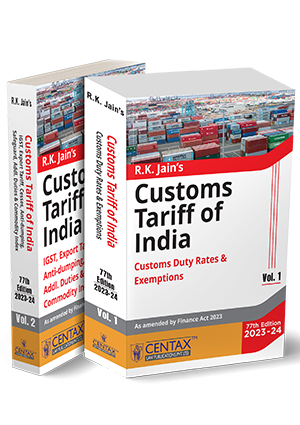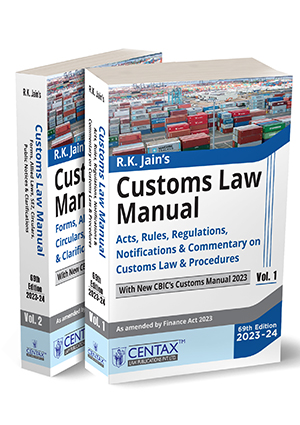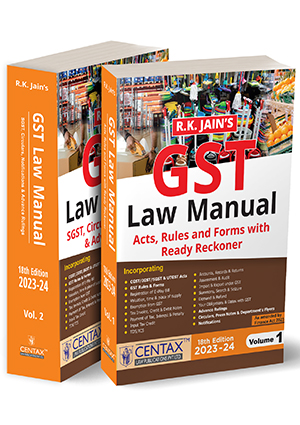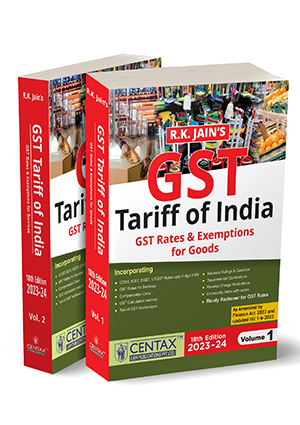Concept of Supply Under GST – Composite Supplies | Service Taxation
- Blog|GST & Customs|
- 17 Min Read
- By Taxmann
- |
- Last Updated on 16 March, 2024

Table of Contents
- Introduction
- Electric vehicle charging – Infrastructure v. Goods
- Storage and material handling vis-à-vis place of supply with regard to location of immovable property
- Cleaning of property vis-à-vis letting out of property
- Composite supply vis-à-vis scenario where price of each individual element is identifiable
- Leasing of property used for commercial operations along with equipment and assets used for commercial operations
- Off airport parking with transport service to terminal and relevance of pricing model
- Licensing of standardised software followed by subsequent customisation
- Freight services in relation to import of goods into India – Issue of separate taxing of shipping services
- Minimum commitment period under contract – Damages vis-a-vis supply scenario
- Retention of deposit received towards hotel room booking when reservations cancelled
Check out Taxmann's GST Law Simplified with Relevant Case Laws which is a comprehensive guide to simplifying GST laws, offering clarity through case law analysis. Targeted at professionals and novices, it covers critical topics like registration, levy, and cross-border services, enriched with case studies and a comparative analysis of GST and EU VAT. It is an educational tool, providing a practical approach and expert insights for adequate understanding and application of GST laws.
1. Introduction
While the term “supply” has been sought to be defined u/s 7 of CGST Act, 2017 and it has been broadly defined, there could be cases other than the ones falling u/s 7(1A) which cannot be specifically classified as “supply of goods” or as “supply as services”. This is especially true for composite supplies defined u/s 2(30) to mean a supply made by a taxable person to a recipient consisting of two or more taxable supplies of goods or services or both, or any combination thereof, which are naturally bundled and supplied in conjunction with each other in the ordinary course of business, one of which is a principal supply. Composite supplies could pose problems to assessees in classification under GST considering emerging business trends notwithstanding the fact that we have few judicial precedents in both service tax as well as VAT to rely on. Luckily, for us, we have quite a few decisions in the European Union from the European Court of Justice over the last twenty years or so dealing with the aspect of composite supplies which could make things easier for us. Some of these decisions would also be of help to lawmakers as well as they deal with emerging business trends and practices. In this chapter we shall look at some of the defining court decisions on concept of supply as well as composite supply.
2. Electric vehicle charging – Infrastructure v. Goods
In Director of National Tax Information Poland v. P. In W. (Case C 282/22 decided on 20.04.2023), the issue before the Tenth Chamber of ECJ on a preliminary ruling was classification of the activity of charging of electric vehicles. The assessee was planning to install and operate electric vehicle recharging stations which were to be accessible to the public. The price to be charged to the users would depend on the duration of the recharging sessions i.e. hours for slow charge connectors and minutes for quick charge connectors. The arrangement broadly would involve the following –
(a) Access to recharging devices, including integration of the charger with the vehicle operating system
(b) The supply of electricity, within duly adjusted parameters, to the batteries of the vehicle; and
(c) The necessary technical support.
A website or an IT application would enable the user to reserve a particular connector and to view his or her transaction and payment history. For the entire arrangement there would be a single price to be charged to the user. While the tax authority was of the view that the predominant element in the arrangement was supply of electricity with recharging facility having only secondary importance, P. in W. was of the view that principal supply was providing access to recharging station based on technologically advanced devices being provided and the convenience involved for user as a consequence thereof.
The Chamber was of the view that all the circumstances in which the transaction concerned were to take place had to be taken into account in order to ascertain its characteristic elements and to identify its predominant elements. The elements in question had to be determined from the point of view of the typical consumer of recharging points and having regard, in an overall assessment, to the qualitative and not merely quantitative importance of the elements of supply of services in relation to the elements of supply of goods.
Moreover, given that the marketing of goods was always accompanied by a minimal supply of services, only services other than those which necessarily accompanied the marketing of those goods can be taken into account for the purpose of assessing the part played by the supply of services within the whole of a complex supply which also involved the supply of the goods. Applying this principle, a supply of electricity to the batteries of an electric vehicle required the use of suitable recharging devices, which might include a charger which is to be integrated with the vehicle operating system.
Consequently, granting access to those devices constituted a minimal supply of services which necessarily accompanied the supply of electricity and need not, accordingly, be taken into account for the purpose of assessing the part played by the supply of services within the whole of a complex transaction which also involved the supply of electricity. The technical support which may be necessary for the users concerned constituted for its part, not an end in itself, but a means of better enjoying the supply of the electricity necessary to propel the electric vehicle. It thus constituted a supply which was ancillary to the supply of electricity.
The provision of IT applications enabling the user concerned to reserve a connector, to view his or her transaction history and to purchase credits for the purpose of paying for recharging sessions offered the user certain additional practical facilities whose sole purpose was, on the one hand, to improve the transfer of the electricity necessary to recharge his or her vehicle and, on the other, to provide an overview of previous transactions.
Note: The transfer of electricity constituted the characteristic and predominant element of the single complex/composite supply on the vehicle recharging activity and that the entire arrangement amounted to supply of electricity or in other words, supply of goods. Convenience for customers for online booking or getting the recharge done quickly through technologically advanced devices being made available would only be incidental to supply of electricity.
3. Storage and material handling vis-à-vis place of supply with regard to location of immovable property
There could be occasions where composite supply of services could alter the equation in terms of place of supply provisions applicable thereto. In Minister for Finance v. RR Donnelley Global Turnkey Solutions Poland sp. z o.o. (Case C-155/12 decided on 27.06.2013) [2013] 35 taxmann.com 525 (FCJ), the issue before the First Chamber of the ECJ was whether or not a composite supply of storage of goods in a warehouse would be subject to place of supply provision as applicable to services in relation to immovable property i.e. place of supply to be determined with reference to location of warehouse.
The services involved were admission of the goods to a warehouse, placing them on the appropriate storage shelves, storing those goods, packaging the goods for customers and issuing, unloading and loading the goods. In addition, for certain contractual partners who were suppliers of goods to computer companies, the service at issue also included the repackaging, into individual sets, of materials supplied in collective packaging. The provision of storage space was only one of several elements of the logistics process which the service supplier managed. The Tax authority went by the location of the warehouse for determining place of supply of the services in question.
The Court relied on its earlier Rulings to reiterate the view that a supply must be regarded as a single supply where two or more elements or acts supplied by the taxable person are so closely linked that they form, objectively, a single, indivisible economic supply, which it would be artificial to split. A supply must be regarded as ancillary to a principal supply if it does not constitute for customers an end in itself but a means of better enjoying the principal service supplied.
The Court relied on the view of the Advocate General to hold that where a large number of services are connected in one way or another with the immovable property, it is necessary that the supply of services should relate to the immovable property itself. That is specific immovable property must expressly be considered or constituted to be a central and essential element of the supply of service for its location to determine place of supply of service. This would be possible where the recipient of that service is expressly given a right to use all or part of specific immovable property.
Note: Where the service recipient has no right of access to the part of the property where their goods are stored or that the immovable property in which those goods are to be stored does not constitute a central and essential element of the supply of services, the place of supply cannot be determined with reference to the location of the property/warehouse in question.
Therefore, the storage had to constitute the principal service of a single transaction and the recipients of that service had to be given an express right to use all or part of the specific immovable property for its location to matter to determine place of supply of storage and material handling service. Location of warehouse therefore not relevant where composite storage and logistics services involved.
4. Cleaning of property vis-à-vis letting out of property
It is quite possible to have cleaning services in relation to apartments as distinct from the activity of letting out of apartments. In RLRE Tellmer Property sro v. Tax Directorate of Ústí nad Labem (Case C 572/07 decided on 11.06.2009) [2012] 23 taxmann.com 244/36 STT 257 (ECJ), the Second Chamber of the Court regarded letting out of apartment and cleaning service in relation to common areas as independent, mutually divisible operations as the charges were collected separately from rent and the cleaning was done through caretakers. The tenants were also in a position to source such services independently from third parties.
5. Composite supply vis-à-vis scenario where price of each individual element is identifiable
There can be circumstances where each element of a supply carries an identifiable price which can be distinguished from price charged for other elements of the supply. Just because price is separately identifiable, does not necessarily mean that each of the elements will be taxed separately. In Stadion Amsterdam CV v. Secretary of State for Finances, Netherlands (Case C 463/16 decided on 18.01.2018), the issue before the Ninth Chamber of the Court was regarding taxability of service of admission to the AFC Ajax Museum which was housed inside the football stadium complex. It was not possible to visit the museum without participating in the guided tour of the stadium.
The Tax Authority was of the view that admission to museum had to be taxed at the same rate applicable to tour of the stadium.
The Chamber held that a single supply, comprised of two distinct elements, one principal, and the other ancillary, which, if they were supplied separately, would be subject to different rates of VAT, must be taxed solely at the rate of VAT applicable to that single supply, (that rate being determined according to the principal element), even if the price of each element forming the full price paid by a consumer in order to be able to receive that supply can be identified. The visit to the AFC Ajax museum amounted to an element that was ancillary to the guided tour of the stadium and therefore admission to museum could not be taxed at another rate.
Note: Supplies cannot be split up just because certain elements have prices individually assigned to them. If the mix has certain elements assuming the character of principal elements and the others being ancillary thereto, the mix would be treated as composite supply.
6. Leasing of property used for commercial operations along with equipment and assets used for commercial operations
The question that can arise at times is whether or not a lease contract for leasing an immovable property which was used for commercial purposes and for all capital equipment and inventory items necessary for that use constitute a single supply of ‘letting of immovable property’.
In Mr Virgil Mailat, Mrs Delia Elena Mailat, and Apcom Select SA v. National Anticorruption Directorate (Case C 17/18 decided on 19.12.2018), one of the issues before the Tenth Chamber of the Court was taxability of a leasing arrangement where the lessor had leased immovable property used for running a restaurant along with fixed assets and/or equipment used for operating the restaurant to another enterprise which continued to operate the restaurant under the same name.
The Chamber was of the view that where the letting of the movable property included in the lease contract did not appear to be dissociable from the letting of the immovable property and especially if some of the movable property, such as the equipment and kitchen appliances, were incorporated in that immovable property, they had to considered as an integral part of that property. As the movable property that was let, or, transferred, at the same time as the immovable property, was also used for the operation of the restaurant in the same way as that immovable property, that letting/transfer could not be regarded as having its own purpose either, but had to be treated as a means of better enjoying the principal service supplied, that was, the letting of the immovable property.
Note: Therefore, the letting of the immovable property had to be regarded as constituting the principal service supplied to which the other services, that is, the letting of capital equipment and inventory items, were merely ancillary as these did not have any distinct object in themselves. This verdict would have a bearing on Schedule II of our CGST Act 2017 owing to differences in treatment of supply of goods as compared to supply of services.
7. Off airport parking with transport service to terminal and relevance of pricing model
In Purple Parking Ltd. & Airparks Services Ltd. v. Commissioners for Her Majesty’s Revenue & Customs (Case C 117/11 decided on 19.01.2012), the issue before the Seventh Chamber of The Court was taxability of services of transport of passengers from off airport car park facility to the airport terminal by the car park operator.
The car parks operated by the appellants were located some distance away from various national airports. They paid particular attention to the safety of those car parks. The car parks were securely fenced and were floodlit at night. They were all covered by CCTV surveillance, and they were also patrolled at regular intervals, 24 hours per day and 7 days per week. Customers drove their vehicles to the car park, left them in an arrivals area and then boarded a bus or mini-bus provided by the car park operator in order to be transported, with their luggage, to the airport terminal. Their vehicles were parked by the employees of that operator. On their return, the customers again used the means of transport provided by the car park operator between the airport terminal and the car park, where their vehicle was made available in a departure area. The transport service was designed to be available at all times and in a sufficiently frequent and reliable manner, with the buses leaving either at regular intervals or on demand.
The brochures provided by the appellants to customers emphasised the safety of the car park and the efficiency and simplicity of the parking operation and convenience of buses to move to terminal with driver helping with the luggage. The price charged by the appellants to their customers was entirely by reference to the time, calculated per day, that the vehicles were parked in the car park. The number of passengers was irrelevant and the transport was not charged separately.
The Chamber was of the view that several formally distinct services, which could be supplied separately and thus give rise, separately, to taxation or exemption, must be considered to be a single transaction when they are not independent. The fact that, in other circumstances, the elements in issue could be or were supplied separately was of no importance, given the fact that possibility is inherent in the concept of a single composite transaction.
The Chamber was of the view that since appellants charged their customers a single price, which may be an indication, without being decisive, there could be a single supply. Moreover, the amount of the price to be paid was exclusively calculated on the basis of the period for which the vehicle was parked, whereas the number of passengers and the extent of use of the transport were irrelevant. This reflected the interests of the parties concerned.
The customer sought, first and foremost, parking at an advantageous price. By contrast, the transport service was only the inevitable consequence of the fact that the car park was located at a certain distance from the airport, with the location accepted by the customer given the fact that the distance allowed him to pay less for the parking service. Secondly, the car park operator offered the transport service in order to be capable, in spite of that distance, of competing with the parking within the airport. The Chamber also highlighted the car park safety measures which were particularly important for the customers in the light of the fact that, on average, they parked their vehicles for several days.
Note: Therefore, for the purpose of determining the rate of VAT applicable, services for the parking of a vehicle in an ‘off-airport’ car park and for the transport of the passengers of that vehicle between that car park and the airport terminal concerned had to be regarded as a single complex supply of services in which the parking service was the predominant element.
8. Licensing of standardised software followed by subsequent customisation
The question that can arise at times is whether or not supply of standardised software on a medium followed by subsequent customisation to tune it to customer requirements can be seen as a single supply and be treated as supply of service. In Levob Verzekeringen BV and OV Bank NV v. Secretary of State for Finance (Case C 41/04 decided on 27th October 2005) [2012] 22 taxmann.com 174 (ECJ) the issue before the First Chamber of The Court was whether or not the customisation of software following licensing of standardised software for an insurance service provider, would make the entire arrangement a supply of service.
The Chamber in this case looked at the fact that the software was of limited use to the customer unless it was customised so as to enable him to manage insurance contracts. The extent, duration and cost of customisation was also significant in this case and the Chamber was of the view that the entire arrangement had to be seen as a supply of service even if separate prices were charged for licensing of standardised software and for customisation portion. Consequently, this impacted the place of supply of such services.
Note: Usability of software with or without customisation will have to be seen at times to see whether or not initial supply and subsequent customisation could be part of composite supply. Case for composite supply increases where customisation is a must for effective and efficient use of software.
9. Freight services in relation to import of goods into India – Issue of separate taxing of shipping services
One of the issues which came up before Courts in India was whether or not the freight/shipping services used to import goods into India could be taxed separately as a service even where the contract entered into by the importer in India with his supplier abroad was on “CIF” Incoterms basis. The three Members Bench of the Supreme Court in Union of India & Anr. v. M/s Mohit Minerals Pvt Ltd (Civil Appeal No. 1390 & 1394 of 2022 decided on 19.05.2022) [2022] 138 taxmann.com 331/61 GSTL 257/92 GST 101 (SC) held that shipping services could not be subjected to tax separately as service under CIF contract for procuring goods.
The provisions of composite supply in the CGST Act (and the IGST Act) play a specific role in the levy of GST. The idea of introducing ‘composite supply’ was to ensure that various elements of a transaction are not dissected and the levy is imposed on the bundle of supplies altogether. This finds specific mention in the illustration provided under Section 2(30) of CGST Act, where the principal supply is that of goods. Thus, the intent of the Parliament was that a transaction which includes different aspects of supply of goods or services and which are naturally bundled together, must be taxed as a composite supply.
On a conjoint reading of Sections 2(11) and 13(9) of the IGST Act, read with Section 2(93) of the CGST Act, the import of goods by a CIF contract constituted an “inter-state” supply which could be subject to IGST where the importer of such goods was the recipient of shipping service.
In a CIF contract, the supply of goods is accompanied by the supply of services of transportation and insurance, the responsibility for which lies on the seller (the foreign exporter in this case). The supply of service of transportation by the foreign shipper forms a part of the bundle of supplies between the foreign exporter and the Indian importer, on which the IGST is payable under Section 5(1) of the IGST Act read with Section 20 of the IGST Act, Section 8 and Section 2(30) of the CGST Act.
Note: Since the Indian importer was liable to pay IGST on the ‘composite supply’, comprising of supply of goods and supply of services of transportation, insurance, etc. in a CIF contract, a separate levy on the Indian importer for the ‘supply of services’ by the shipping line as proposed by Revenue Authorities would be in violation of Section 8 of the CGST Act. The levy imposed on the ‘service’ aspect of the transaction was in violation of the principle of ‘composite supply’ enshrined under Section 2(30) read with Section 8 of the CGST Act.
A tax on the supply of a service, which had already been included by the legislation as a tax on the composite supply of goods, could not be allowed. The aspect theory did not allow the value of goods to be included in services and vice versa.
10. Minimum commitment period under contract – Damages vis-a-vis supply scenario
At times a question can arise as to whether or not there is a supply where a contract is terminated by the customer prematurely leading to claim for damages from the supplier. While there are decisions under service tax in the Indian context where damages or compensation has been held not to be liable in the absence of a supply, there could be scenarios where claim for damages could be distinguishable from claims which are regarded as arising out of commitment by supplier under contract. In MEO v. Tax and Customs Authority, Portugal (Case C 295/17 decided on 22.11.2018), the Fifth Chamber of the Court was asked to provide a preliminary ruling on taxability of amount received by supplier of telecommunication service for the period running from termination of contract by the customer and upto the minimum commitment period for which he was supposed to receive service. This was where there was premature termination of contract by customer for reasons attributable to him. The supplier wanted to treat the amount received as compensation while the amount he received was equal to the amount he would have received had the customer availed of services for the minimum commitment period.
The Court was of the view that the direct link between the service supplied to the recipient and the consideration actually received is established by the fact that consideration is defined at the time of signing of the contract based on the right derived by the customer or the right given to him to require the fulfilment of the obligations by the supplier under the contract, irrespective of whether or not the customer uses such right. Thus, that supply is made by the supplier of services when it places the customer in a position to benefit from the supply, so that the existence of the abovementioned direct link is not affected by the fact that the customer does not avail himself of that right. The Court therefore was of the view that this was not damages. Classification of amount received as damages or penalty under national law would also not make a difference in terms of its taxability.
Therefore, the amount payable for non-compliance with the minimum commitment period was payment for the services provided by MEO and identified at the time of signing of the contract, regardless of whether or not the customer exercised the right to benefit from those services until the end of the minimum commitment period. This was consequently held liable to tax.
A view similar to the one above has been taken in Vodafone Portugal v. Tax And Customs Authority Portugal (Case C 43/19 decided on 11.06.2020) [2020] 118 taxmann.com 59 (ECJ) where the Ninth chamber of the Court held amounts received by telecommunication service provider as being liable to tax where customer had opted for termination before end of tie in period even if the amounts received were quantified using an approach distinct from the one involved in MEO’s case.
Note: Readers should note that the issue here was taxability of charges received for a period for which service was committed by the supplier. The charges were received upfront. Where the customer had not used the service for the full service period, the supplier wished to take a view that charges related to period for which service had not been used, was to be seen as compensation for early termination. This was not agreed to by Court. It will be interesting to see views of Indian courts in similar arrangements moving forward. The impact of regulations concerning service delivery will also be relevant to identify scenarios where this verdict can be applied.
It also remains to be seen whether or not Courts uphold Para 11 of Circular 178/10/2022 dated 03-08-2022 as it appears to go against the confirmation of Tribunal in the context of service tax as well as the general understanding that cancellation charges would not be liable to tax. Para 11 of the Circular for the record seeks to club cancellation services as part of bundled supply of principal service.
11. Retention of deposit received towards hotel room booking when reservations cancelled
Can deposit retained by hotelier on cancellation of reservation of hotel room booking by customer, be construed as consideration for supply? This question arose in Société Thermale v. Ministry of The Economy, Finance & Industry (Case C 277/05 decided on 18.07.2007) [2013] 32 taxmann.com 301 (ECJ) before the First Chamber of The Court on a reference for Preliminary Ruling with regard to Articles 2(1) and 6(1) of the Sixth Directive 77/388/EEC of 17 May 1977 which dealt with tax liability on obligations to refrain from an act or to tolerate an act or situation. This is very similar to the clause we have under Schedule II to CGST Act 2017 [i.e. Clause 5(e)].
Disclaimer: The content/information published on the website is only for general information of the user and shall not be construed as legal advice. While the Taxmann has exercised reasonable efforts to ensure the veracity of information/content published, Taxmann shall be under no liability in any manner whatsoever for incorrect information, if any.
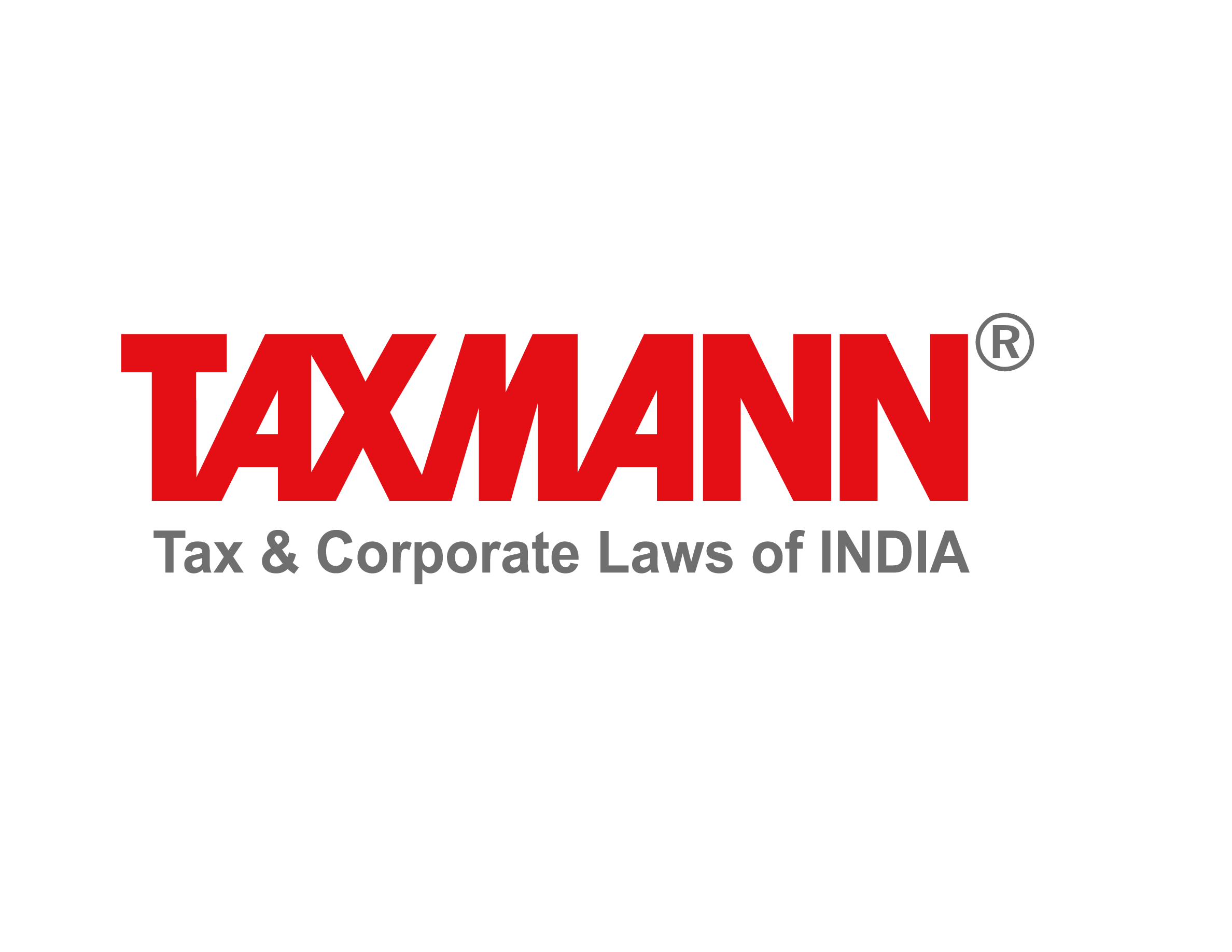
Taxmann Publications has a dedicated in-house Research & Editorial Team. This team consists of a team of Chartered Accountants, Company Secretaries, and Lawyers. This team works under the guidance and supervision of editor-in-chief Mr Rakesh Bhargava.
The Research and Editorial Team is responsible for developing reliable and accurate content for the readers. The team follows the six-sigma approach to achieve the benchmark of zero error in its publications and research platforms. The team ensures that the following publication guidelines are thoroughly followed while developing the content:
- The statutory material is obtained only from the authorized and reliable sources
- All the latest developments in the judicial and legislative fields are covered
- Prepare the analytical write-ups on current, controversial, and important issues to help the readers to understand the concept and its implications
- Every content published by Taxmann is complete, accurate and lucid
- All evidence-based statements are supported with proper reference to Section, Circular No., Notification No. or citations
- The golden rules of grammar, style and consistency are thoroughly followed
- Font and size that’s easy to read and remain consistent across all imprint and digital publications are applied
